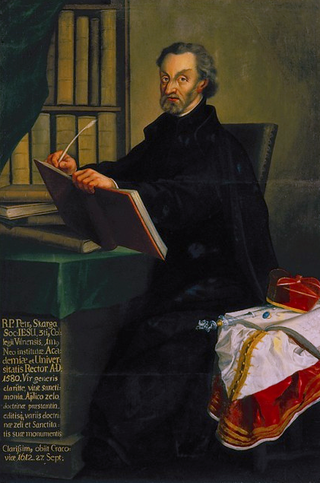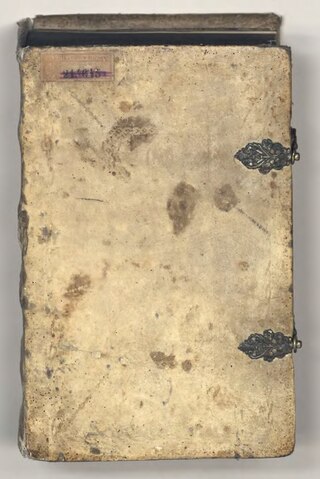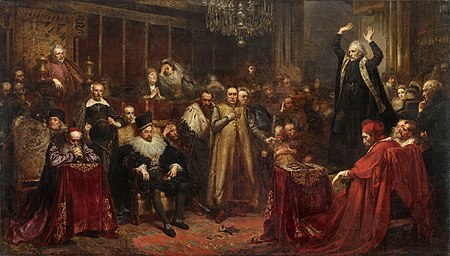
Jan Alojzy Matejko was a Polish painter, a leading 19th-century exponent of history painting, known for depicting nodal events from Polish history. His works include large scale oil paintings such as Rejtan (1866), the Union of Lublin (1869), the Astronomer Copernicus, or Conversations with God (1873), or the Battle of Grunwald (1878). He was the author of numerous portraits, a gallery of Polish monarchs in book form, and murals in St. Mary's Basilica, Kraków. He is considered by many as the most celebrated Polish painter, and sometimes as the "national painter" of Poland. Matejko was among the notable people to receive an unsolicited letter from the German philosopher Friedrich Nietzsche, as the latter tipped, in January 1889, into his psychotic breakdown while in Turin.

Jan Sariusz Zamoyski was a Polish nobleman, magnate, statesman and the 1st ordynat of Zamość. He served as the Royal Secretary from 1565, Deputy Chancellor from 1576, Grand Chancellor of the Crown from 1578, and Great Hetman of the Crown from 1581.

Piotr Skarga was a Polish Jesuit, preacher, hagiographer, polemicist, and leading figure of the Counter-Reformation in the Polish–Lithuanian Commonwealth. Due to his oratorical gifts, he has been called "the Polish Bossuet".

Janusz Radziwiłł was a noble and magnate of the Polish–Lithuanian Commonwealth. He was the deputy cup-bearer of the Grand Duchy of Lithuania since 1599, the castellan of Vilnius since 1619, and the starost of Borysów. Radziwiłł also held the title of Reichsfürst of the Holy Roman Empire.

Jerzy Mniszech was a Polish nobleman and diplomat in the Polish–Lithuanian Commonwealth. Member of the House of Mniszech. Krajczy koronny in 1574, castellan of Radom in 1583, voivode of Sandomierz Voivodship in 1590, żupnik ruski, starost of Lwów in 1593, starost of Sambor, Sokal, Sanok, Rohatyn.

Mikołaj Zebrzydowski (1553–1620) of Radwan coat of arms, voivode of Lublin from 1589, Grand Crown Marshal between 1596–1600, voivode of Kraków from 1601. He is famous for an armed rebellion against King Sigismund III Vasa, the Zebrzydowski Rebellion, a rokosz named after himself. It took place in 1606, and was defeated by 1607. After the failed rebellion, he sponsored the creation of the Roman Catholic monastery of Kalwaria Zebrzydowska, which is regarded as one of the most important pilgrimage sites of Poland.

Stanisław Stadnicki, a Polish nobleman, Lord Starosta of Żygwulsko (Sigulda), a known troublemaker, called 'the Devil of Łańcut' for his violent behaviour. Lord of the castle in Łańcut. Enemy of Jan Zamoyski, Grand Chancellor of the Crown in 1606 he became one of the leaders of the rokosz of Zebrzydowski. From his Łańcut castle he organised many assaults (zajazdy) at the estates of Łukasz Opaliński and Anna Ostrogska.

Stanisław Karnkowski of Junosza (1520–1603) was the Great Referendary of the Polish Crown, the Great Secretary of Poland, bishop of Włocławek (1567-1580) as well as archbishop of Gniezno and Primate of Poland. He served during the Interrex in 1586–1587, before the coronation of Sigismund III Vasa.

Jan Piotr Sapieha was a Polish-Lithuanian nobleman, general, politician, diplomat, governor of Uświat county, member of the Parliament and a skilled commander of the Polish troops stationing in the Moscow Kremlin.

The Jan Matejko Academy of Fine Arts in Kraków, is a public institution of higher education located in the centre of Kraków, Poland. It is the oldest Polish fine art academy, established in 1818 and granted full autonomy in 1873.

The Battle of Grunwald is a painting by Jan Matejko depicting the Battle of Grunwald and the victory of the allied Crown of the Kingdom of Poland and Grand Duchy of Lithuania over the Teutonic Order in 1410. The canvas dates to 1878 and is one of the most heroic representations of the history of Poland and Lithuania. It is displayed in the National Museum in Warsaw.

Artur Grottger was a Polish Romantic painter and graphic artist, one of the most prominent artists of the mid 19th century under the partitions of Poland, despite a life cut short by incurable illness.

Princess Elizaveta Ostrogska (1539–1582), also known as Elżbieta or Halshka, was a Ruthenian heiress, the only child of Prince Illia Ostrogski and Beata Kościelecka.

Stańczyk is a painting by Jan Matejko finished in 1862. This painting was acquired by the Warsaw National Museum in 1924. During World War II it was looted by the Nazis and subsequently by the Soviet Union, but was returned to Poland around 1956.

The Prussian Homage is an oil on canvas painting by Polish painter Jan Matejko painted between 1879 and 1882 in Kraków. The painting depicts the "Prussian Homage", a significant political event from the time of the Renaissance in Poland in which Albrecht of Hohenzollern, the Duke of Prussia paid tribute and swore allegiance to King Sigismund I the Old in Kraków's market square on 10 April 1525. Matejko depicted over thirty important figures of the Polish Renaissance period, taking the liberty of including several who were not actually present at the event.

The Hanging of the Sigismund Bell is a painting by Jan Matejko finished in 1874. It depicts the installation of the Sigismund Bell in the Wawel Cathedral in Kraków in 1521. The bell was installed in the Sigismund Tower and rung for the first time on 13 July 1521. The bell is considered to be one of the national symbols of Poland. This painting is one of a number of historical paintings by Matejko. It shows a crowd of people, with a number of identifiable figures of historical importance. It conveys the Golden Era of the Polish Renaissance, and the power of the Kingdom of Poland.

The Lives of the Saints from the Old and New Testaments is a hagiography by Polish Jesuit Piotr Skarga. It became one of the most popular Polish books ever and a classic of Polish literature. It is one of two most famous works by Skarga, the other being Sejm Sermons.

Sejm Sermons or the Eight sermons before the Sejm, is a political treatise by Polish Jesuit Piotr Skarga, published in 1597. It is one of two most famous works by Skarga, the other being Żywoty świętych.

The Kraków Society of Friends of Fine Arts is a social group of artists, artisans and their supporters founded in Kraków in 1854, under the Austrian Partition of Poland. Today, the Society operates from the Art Nouveau Palace of Art erected by its own members in 1901 at the Szczepański Square in Kraków Old Town. After major renovations of the Palace in 1996, the Society organizes local and international art exhibits and numerous other art initiatives.

Józef Unierzyski was a Polish painter. From 1891, he served as a Professor of drawing at the Jan Matejko Academy of Fine Arts in Kraków.



















